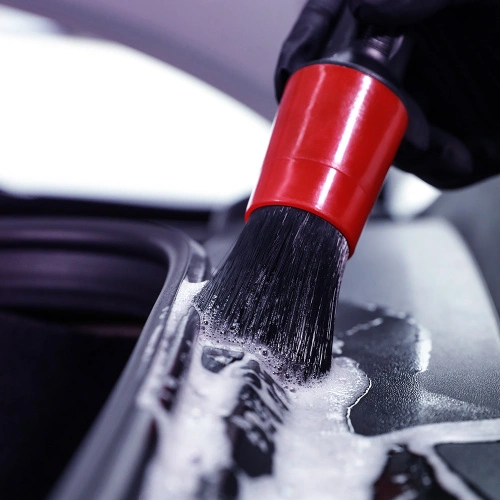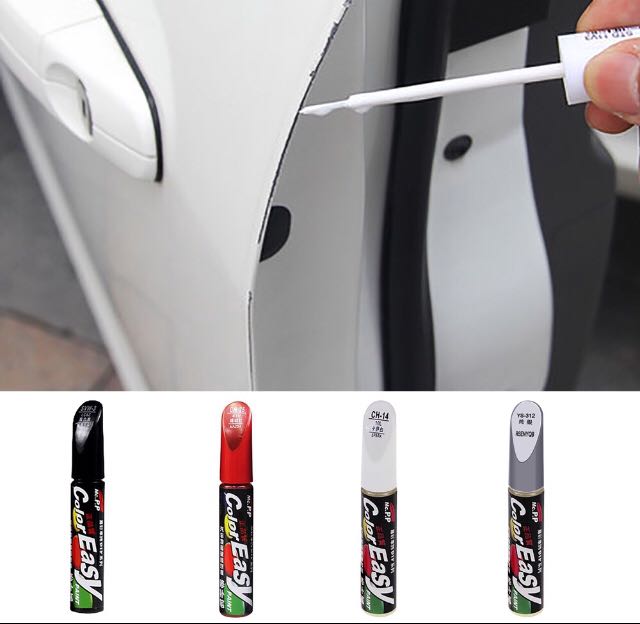
Painting model car bodies is one of the most fun aspects of the hobby. The two main decisions facing you are (1) what type of paint to use, and (2) how to apply the paint, and (3) whether to polish and wax.
1) Type of Paint
Apply paint to the car using the 4-inch roller. Soak up just a small amount of paint and then force the paint out of the roller. This should produce a thin coat of paint. Use the foam wedge brushes. The next variety is the smaller brush, which is made for getting into crevices of seats, steering wheels, emblems of cars etc. The next variety is carpet and upholstery brushes, which are usually rougher to remove embedded dirt and debris. Usually, they come with a handle which makes them easy to manipulate into more challenging positions. A few weeks after painting your car, no one likes seeing an orange peel texture, cracking or peeling, but exposing your vehicle to the environment right after a fresh paint job can do just that. Some auto enthusiasts recommend keeping your freshly painted car in the garage for at least a month, but at the same time, you need to be realistic. Use nylon or polyester brushes for latex and natural bristle brushes for oil paints. This will make cleanup easier. Good brushwork is to allow only about two inches (or “two fingers”) of paint on the brush before painting. The less unnecessary paint gets on the brush, the less paint.
Every paint has three main components: the pigment which is the color containing part, the resin which binds the pigment to the surface, and the solvent which holds everything together in the liquid form. There are two broad classes of paint, enamels and lacquers. Enamels undergo a chemical reaction (curing) as the solvent evaporates. In lacquers, the solvent evaporates without any curing. Now hobby paints are generally (oil-based) enamels, or aqueous (water-based) acrylic lacquers. The hobby enamels (e.g. Testors, Model Masters, Humbrol) thin with mineral spirits, dry slowly and harden beautifully to a glossy finish. The hobby acrylics (e.g. Tamiya, PollyScale, Floquil, Vallejo) thin with water or alcohol, dry faster, and clean up easier. People tend to develop a preference for one or the other, so try both and see which you prefer.
Above: Assortment of enamel paints.
2) Applying Paint
There are 3 basic methods for applying the paint to the model: brush painting, spray cans, and airbrush. Each method has its advantages and disadvantages.
Brush
The paintbrush is the simplest method of applying paint. It's best suited for painting small parts, as using brushes on the car body will likely result in unsightly brush marks.

Above: An assortment of model paintbrushes, acquired over time.
The key to getting a nice smooth paint job free of brush marks is to minimize overlap of brush strokes. Don't go back and paint over the area you just painted, let the paint level and spread by itself.

After using the brush, clean up with the recommended thinner. For acrylics, you can use soap and water. Shape the bristles of the brush with your fingers so that they are not distorted. Store with the brushes in a cup-like container with bristles pointing upward and into the air.

Spray Can
The spray paint can is the most widely used paint source for model cars. It's advantages over brushing include:
- Smoother paint job with no brush strokes.
- Faster than brushing.
- No cleanup of brushes required.
However, paint cans deliver a wide area spray and so are somewhat wasteful. They end up being more expensive. Also, there is generally a limited range of colors available, and custom mixing of paint colors is out of the question. For multiple colors on a model, masking must be done to limit overspray; spraying outside is also a good idea. The cans tend to cool down as they are used, which reduces the paint flow. Placing them in warm water for a few minutes can fix this. Despite their drawbacks, spray cans can very handy, e.g. for single color models. They are very popular for model car bodies. Testors spray enamels and Tamiya spray lacquers are popular choices.
Important: Start and stop the spray past the ends of the models, not over the model itself. This will help ensure a smooth paint job.
Below: Placing the spray can in warm / hot water for a few minutes before spraying helps the paint go on more smoothly. Make sure to wipe down the can so that no water drips on the model.
Below: Car body placed on bent wire hanger in preparation for spraying lacquer paint.
Airbrush
We think that the airbrush is a great tool for painting small scale car models. When used with a compressor as the air source, it becomes like an infinite spray can, with the great side benefits of control of the pressure and of the amount of paint. These additional controls can be used to used to create fine lines of paint and many other useful effects.
Above: A single action, external mix, siphon (bottom) feed airbrush, the Paasche Model H .
Below: Model car seats painted with the Paasche Model H airbrush and water-based acrylics.
Some basic tips:
- A single action airbrush is simpler, easier to learn, and generally lower cost. It's great for beginners. However, the double action gives you much more control over the paint process.
- A good compressor will be cheaper in the long run than using those cans of compressed air. The compressor will pay for itself after only a few models.
- Use the manufacturer’s recommended thinner. This will keep the paint flowing smoothly without drying too fast.
- To keep the airbrush working smoothly, follow the instructions for cleaning. Improperly cleaned airbrushes are the source of most airbrush issues.
3) Paint Layers
Different types of paint with different purposes are often applied to the same model, in multiple layers. Some of the typical ones are: primer, color coat, and clear coat.

The primer prepares the surface for the following coats of paint. It tends to bond aggressively with the plastic. The primer is also designed to bond well to the paint, reducing any tendency to peel or lift off (especially) when removing masking tape.
Color coats (which are just that) are built up in layers, starting with light mist coats and eventually ending with wet coats.
Clear coats are used for a few reasons. A glossy clear coat provides the best surface for the application of the water slide decals. So if the color coats are flat (matt), and clear gloss coat is applied before the decals. Clear gloss also provides depth and brilliance to a paint job.
How To Remove Saw Dust From Car Paint Brushes
The following photo sequence shows the painting of a 1/24 Porsche Carrera model car body, using lacquer paints from spray cans.
Below: Bare plastic car body, wet-sanded with 600 and 1500 grit wet-or-dry sandpaper.
Below: After first primer coat (Tamiya primer).
Below: After second primer coat.
Below: After first mist coat of Tamiya TS-42 (Gunmetal).
Below: After 2nd mist color coat.
Below: After 1st wet coat.
Below: After 2nd and final wetcoat.
Below: After Tamiya TS-13 clearcoat.
3) Polishing and Waxing
After clear coat, the paint job will look great and you could stop here. But it can look even better with a bit of extra work in polishing and waxing. Polish and wax are both very fine abrasives, the wax being even finer than the polish. You can use model car specific compounds such as Novus, or The Treament. However, polish and wax for real cars works just as well, and is more economical. We used Turtle Wax and Meguiar's brands.
The clear coat will likely not be perfect, so lightly wet-sand it with 1500 grit then 6000 grit, then blow dry. Find a lint-free cloth (an old white t-shirt will work) and apply a small amount of polishing compound. Choose one part of the car (e.g. the bonnet) and spread the polish onto it gently. Then start rubbing in a circular motion, stopping to check your progress every couple of minutes. You'll notice that the surface gets more and more reflective.
Avoid putting lots of pressure on and sharp edges, e.g. between sides and bottom of the car. At sharp edges, the clear coat can be removed with too much pressure, exposing the color coat below. Check the surface of your polishing pad to make sure color coat is not being removed.
After polishing the entire, wash with soap and water and blow dry. Then apply wax in the same manner. Avoid getting too much wax in the panel lines, as you won't be able to wash it out. If there is a buildup there, remove with the sharpened tip of a toothpick.
Finally, step back and enjoy your handiwork!
Below: Automotive polish and wax used on this model car.
Car Paint Brush
Below: After polishing with automotive car polish.
Below: After waxing with automotive car wax. Smooth and shiny!
Send us your comments below! Login with your Facebook, Twitter, Google or Yahoo account.
Car Paint Brush Holder
Please enable JavaScript to view the comments.